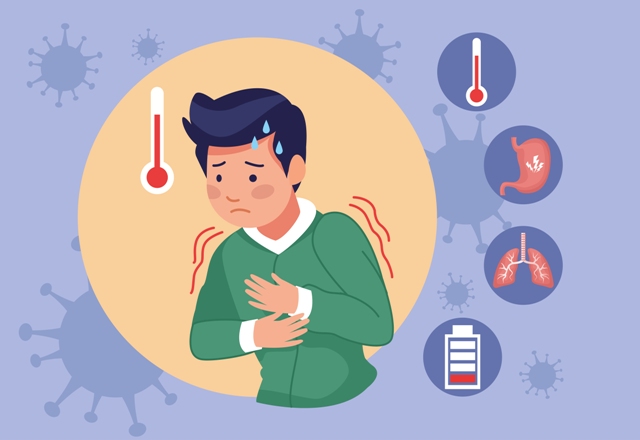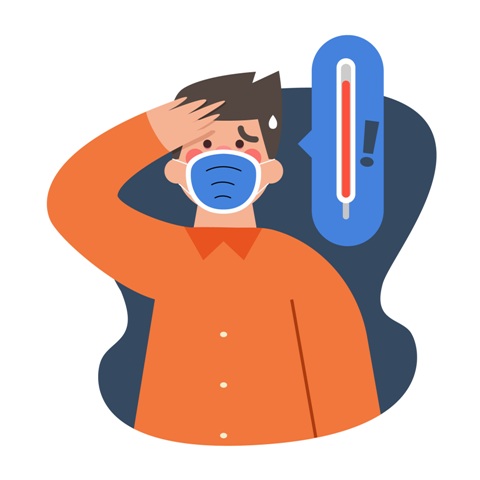Fever is characterised by an elevation in body temperature above the normal, though it is considered as a symptom but not a disease. It mainly indicates that something out of the ordinary is going within the body. It is extremely uncomfortable but it is not considered as a cause for concern until the temperature reaches to 103°F
Causes of fever
It can be caused by various endogenous as well as exogenous factors. Antigen antibody reactions, malignancy are considered as the endogenous causes of fever whereas fungi or virus or bacterial infection is considered as the exogenous causes of fever
Below points will give an overview of developing fever by exogenous agent –
- At first infections develop due to bacteria or fungus
- Then the phagocytes are activated within the bone marrow
- Activated phagocytes are responsible for releasing pyrogen, which is considered as a fever inducing hormone
- After that the synthesis of prostaglandin occurred within body
- These prostaglandins then stimulate the thermoregulatory centre placed in the anterior hypothalamus
- As a result the temperature of body increases
Types
Fever can be of three types, which include –
Short duration fever
- It is very common type of fever and in this type of fever it has seen that the fever is subsided within one weeks
- It is not so severe in its manifestation
- It is mainly developed due to urinary tract infection or respiratory infection or other mild infections
- Viral fever or influenza or dengue or typhoid fever are considered as the common example of short duration fever

Chronic fever
- It is considered as persistent fever
- It may last for more than two weeks
- Proper care should be taken otherwise it may become worse
- Tuberculosis is recognised as an example of chronic fever

Intermittent fever
- It is such type of fever where there is an interval exists in temperature rise and drop
- In this type of fever temperature is elevated for some hours and followed by an interval when temperature drops back to normal
- This type of fever generally occurs during infectious diseases
- Malaria is very common example of intermittent fever
Signs and symptoms
Though fever itself is a symptom of some infectious diseases but individual who suffer from fever may experience the following –
- Shivering or chills
- Light headedness
- Headache
- Fatigue
-
 Sweating
Sweating - Being irritable
- Losing appetite
- Being dehydrated
Metabolic changes in fever
- Fever increases the metabolic rate of the body in many folds as a result the rate of calorie expenditure increases
- It has seen that 7% of metabolic rate increases for each degree Farenheit increase in body temperature
- This increased metabolic rate increases the need of calories as well for restoring the calories that have burned due to high metabolic rate
- In this condition all the stored glycogen are utilised for energy purpose
- When all stored glycogen are finished then the body utilises stored fat from adipose tissue in order to meet the need of energy that results in weight reduction
- Protein catabolism also occurred in this situation as body utilised proteins too for energy purpose, which is responsible for providing additional burden on the kidneys as we know that nitrogenous waste products are produced due to protein catabolism, which is excreted by kidneys
- Increased excretion of body water, sodium and potassium also occurred in high fever condition
So if the body is not restored with proper calories, water and electrolytes then severe damage may occur
Nutritional management
Proper nutritional support is very much important in this condition for early recovery. Nutrition plays vital role in providing sufficient calories as well as electrolytes to the patients, which ultimately help them to reduce their complications

Below points will give an overview of nutrients that are beneficial for febrile condition –
Energy or calorie
- As the metabolic rate increases in many folds thus it is better to consume more calories in order to replenish the calorie expenditure
- It is recommended that individual who suffer from fever should consume 50% extra calories than their normal calorie recommendation
- Calorie intake should be increased as rapidly as possible
- It should be kept in mind that most of the calories should come from carbohydrates

Carbohydrates
- About 70% of daily calories should come from carbohydrates
- Carbohydrate intake should be increased in order to meet the calorie need and also for restore glycogen
- Focus should be given on simple carbohydrate consumption as they are readily absorbable and help to provide instant energy. Whereas consumption of complex carbohydrate should be avoided
- Diet should contain enough amount of refine wheat products, rice, raw sugar, fruit juice concentrate, honey, glucose etc
Proteins
- Protein is another important nutrient that plays vital role in improving the symptoms of fever
- 100 gm of proteins should be consumed daily if the fever lasts for long period of time
- Protein helps to improve the immunity of the body and also helps to make the body able to fight against infections (exogenous causes of fever)
- Diet should contains adequate amount of milk or non fat dairy products, pulses, legumes, soybeans, lentils, egg, fish and chicken

Fat
- We all know that fat is considered as a caloriegenic nutrient as it contributes enough energy on its oxidation. Though the need of energy increases in febrile condition but intake of too much fat for meeting the increased need of energy is not desirable
- The need of energy should be met from carbohydrates not from fats because in febrile condition the body losses its normal ability of digestion thus it becomes really very tough to digest fat thus it is better to consume fat in moderation
- Consumption of fried foods should be strictly avoided
Vitamins
- All the vitamins are extremely important in this condition
- Vitamin B complex should be consumed to support the increased catabolic rate of the body. Diet should contain legumes, nuts, dairy products, vegetables, eggs as they all are rich in B vitamins
- Whereas diet should contain adequate Vitamin A as well, carrot, broccoli, cabbage and tomatoes should be incorporated in diet as they contain adequate amount of Vitamin A
- Diet should contain Vitamin K rich food too. It has seen that there is a decrease in the number of intestinal beneficial microbes occurred due to the uses of antibiotics thus it is better to focus on Vitamin K consumption in order to restore them. Spinach, broccoli and other green leafy vegetables should be included in diet as they are rich source of Vitamin K
- Vitamin C is also needed during this condition thus diet should contain citrus fruits as well

Minerals
- All the minerals should be consumed as per recommendation and special consideration should be given to sodium, potassium and chlorine in order to maintain electrolyte balance
- Supplementation can be provided if required
Fluid
- Proper intake of fluid is very much important in febrile condition
- It helps to replenish the water that has lost during sweating
- Whereas it is also associated with excreting wastes from body by promoting urination
- It is better to consume 2500 to 4000 ml of fluids per day including soup, fruit juices, beverages and water
The above stated nutritional guideline is extremely useful for preventing fever and it is better to consume small quantities of foods at an interval of 2 to 3 hours

Source:
Kavanagh, F.A., Heaton, P.A., Cannon, A. and Paul, S.P., 2018. Recognition and management of febrile convulsions in children. British Journal of Nursing, 27(20), pp.1156-1162.
Laino, D., Mencaroni, E. and Esposito, S., 2018. Management of pediatric febrile seizures. International journal of environmental research and public health, 15(10), p.2232.
Ma, L. and McCauley, S.O., 2018. Management of pediatric febrile seizures. The Journal for Nurse Practitioners, 14(2), pp.74-80.
Mitsakakis, K., D'Acremont, V., Hin, S., von Stetten, F. and Zengerle, R., 2018. Diagnostic tools for tackling febrile illness and enhancing patient management. Microelectronic engineering, 201, pp.26-59.
Pantell, R.H., Roberts, K.B., Adams, W.G., Dreyer, B.P., Kuppermann, N., O’Leary, S.T., Okechukwu, K., Woods, C.R., Byington, C.L., Lavelle, J.M. and Lye, P.S., 2021. Evaluation and management of well-appearing febrile infants 8 to 60 days old. Pediatrics, 148(2).
Smith, D.K., Sadler, K. and Benedum, M., 2019. Febrile seizures: risks, evaluation, and prognosis. American family physician, 99(7), pp.445-450.


